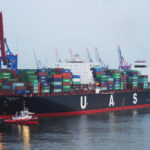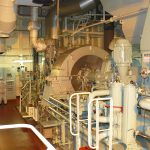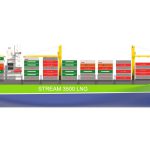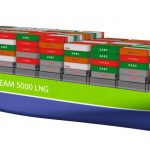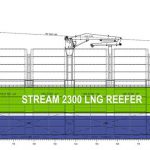STREAM is a design principle that combines various means for energy savings like dual-fuel engines, waste heat recovery, power management system or hull form optimization. The features of the container ship concept are described by the German company Technolog
More than ten years ago the designers, engineers and economists of Technolog GmbH and from the associated design organization IPP[ds_preview] Engineering Partner Pool have been working together with industrial partners to make ship operations even more efficient and environmentally friendly with better economic results. The design team has comprehensive experience and know-how and has followed market trends as well as forthcoming international ecological requirements.
This article describes the rapidly growing acceptance of tailored designs for operational profiles and HFO-LNG dual fuel engines, based also on their own developed most efficient STREAM power generation and propulsion concept with related experience and the achieved improvements.
In the past vessels were developed by shipyards or designers as standard designs just considering high deadweight and required high contract speed on a single design draught to fulfil contractual obligations. For this performance the largest main engines in the market were installed. The only validation of guaranteed fuel oil consumption was under test bed conditions. During the shipbuilding boom times the availability of free building slots was the prime concern of shipowners, banks and investors. With such standard vessels in international trading fuel costs were of secondary consideration.
Already in 2004 Technolog as technical consultants to Middle East liner company United Arab Shipping Company (UASC) assisted the shipowner to incorporate waste heat recovery system (WHRS) retrofit possibilities for their eight 6,900 TEU container ship new buildings (A7) constructed by Hyundai Heavy Industries (HHI) with Wärtsilä 11 RT-flex 96C main engines. The additional investments related to the expected energy savings of up to 10 % did not provide sufficient benefits with the still low fuel prices at that time. Only with their next series of 13,500 TEU ships (A13) the WHRS became commercially interesting due to the already drastically increased fuel prices and all nine vessels were equipped with steam and power turbines and Siemens shaft generator/shaft motor with unique power management system.
In this way UASC became the second ship operator with such equipment worldwide (Fig. 1). Naturally, also these ships with all equipment including the WHRS (Fig. 2) were basically designed as a standard from Samsung Heavy Industries (SHI) for the high speeds, so a lot of efforts were made eventually to retune the MAN B&W 12K98ME7 main engines for WHRS output at also lower engine loads.
After the great crisis in 2008/09 the focus in shipping has changed to higher efficiency and environmental awareness. Shipping today is governed by overcapacities and low transport volumes, low freight rates, high fuel oil costs and tendencies by shipowners and managers to seek synergies for cost reduction by joint operations and alliances in order to survive. Slow steaming has assisted to cut fuel bills, but low engine loading means ineffective SFOC (specific fuel oil consumption) values, and low cargo weights and reduced speeds mean ineffective bulbous bows and hull lines with comparatively high resistance and required high propulsion power.
Technolog and IPP Engineering Partner Pool with their joint project industry partners started the development of the STREAM design principle in 2009, compiling all possible means for energy saving around the announced first dual- fuel 2-stroke main engine by MAN, and considered the special features of LNG, WHRS, PMS (power management system), hull form optimization, energy savers, open-top container arrangement with patented STREAM stow-mix, and particular reefer optimization with new cargo hold ventilation.
This new development was supported by the joint project industry partners: DNV GL/FutureShip, Becker Marine Systems, HSVA, MAN Diesel & Turbo, Alfa Laval Aalborg, MMG Mecklenburger Metallguss, TGE Gas Engineering, Heinen & Hopman as well as Cargotec-MacGregor. The STREAM LNG designs have been adjusted also to latest Wärtsilä 2-stroke engines (Fig. 3, 4 and 5)
Design features
STREAM is an intelligent ship design concept that stands for »Sustainable Transport, Reliable, Economic, AMbitious Technology« with today’s demands by owners, charterers and port operators. It enables best-in-class economical and environmentally friendly ship operations – now, tomorrow and in future.
Within the STREAM development the dual-fuel application for global utilization was a prime driver and not only for ECA zones. For ships with such endurance, »C« type tanks were considered, and for the best tank space utilization these were arranged in bilobe shape. The smaller STREAM vessel variants received also the possibility to increase their tank capacities by additional newly invented LNG container with bunker system, for which Technolog received a patent.
All these investigations and innovative STREAM features assisted Technolog to utilize this know-how and experience for the design study on behalf of UASC for most competitive new mega container carriers, which can be listed as:
ultra-long stroke main engines
lower RPM and largest diameter propellers
hull form optimization for operational speeds and draughts
energy saving devices and high performance rudder
LNG (preparation) for fuel with better energy utilization
waste heat recovery system
power management system
energy management system
integrated vessel control system with shore monitoring
total cargo solution for best transport volume and fastest container handling in ports
training of ship’s crew for most competitive utilization of new features.
Challenges are further extended into the future by IMO MARPOL IV regulations on permissible NOx and SOx as well as diesel particle emissions, and the aims for the best Energy Efficiency Design In-dex (EEDI) concerning least CO2 output, where Technolog sees the future with LNG rather than scrubbers or SCRs.
Investments into more competitive ships with greater fuel efficiency generally mean higher initial investments but essentially lower lifetime operating costs! Clear definition of owner-specific operating profiles are a must for vessel design optimizations concerning cargo weights, number of reefer cargo, cruising and catch-up speeds.With the reduced operating speeds of existing tonnage and the analysis of ship deadweight utilizations at present cargo volumes it is very noticeable how poor even recent ship designs are that have been optimized on 25 knots on contractual design draughts. This has caused many shipowners to replace existing bulbous bows against a more flexible bulb design for reduced speeds and draughts with related fuel savings. However, all technical developments and associated cost involved need to be justified. To assist owners with decision taking Technolog has developed and applies special software to make detailed cost/benefit analyses and break-even calculations for basic investments and additional innovative features in relation to the individual operation profile for the vessel, and for each of the intended routes (Fig. 6.1 and 6.5).
Technolog was able to assist UASC to define such most modern requirements in their RFP (request for proposal) and in the subsequent contract specifications. For the operating profile deep studies were made technically and commercially also for both single and twin skeg hull forms (Fig. 7) and propulsion efficiencies with extensive cost-benefit analyses. The fuel saving of twin hull arrangements are remarkable and the earnings from soft facts such as propulsion redundancy with extremely wide range of economic engine operation is in particular environmental friendly.
Further support was given to UASC during the process of tender evaluation, shortlisting, and the final selection of builder. Meanwhile the company has ordered eleven 14,500TEU (A14) and six 18,800 TEU ULCV (A18) to be constructed by Hyundai Heavy Ind. Ltd. and Hyundai Samho Heavy Ind. Ltd. in South Korea. Technolog and UASC have a joint team for plan approval works and construction supervision to maximize long term benefits in ships’ operation with exposure and training of superintendents during ship constructions. The first two vessels will be delivered within 2014 while the last of the series will come into service by autumn 2016. The construction of the first three A14 vessels has started in March 2014 (Fig. 8).
More STREAM orders ahead
For the first series of STREAM 4500LNG container vessels a letter of intent has been signed and negotiations between owner and shipyard are in final phase. The STREAM designs went through hull form optimization with FutureShip (now DNV GL Maritime Services) for optimized hull resistance and bow design as well as wake field aft. The propeller was selected with maximum diameter for the new fuel efficient ultra-long 2-stroke main engine with lowest possible RPM for highest propulsion efficiency. Further enhancements in ship resistance and propulsion could be reached by selection of an effective Becker Twisted Leading Edge Rudder with rudder bulb and also additional energy saver with Becker Twisted Fin pre-swirl. The substantial savings by optimized hull forms done by FutureShip in cooperation with builder HHI and owner UASC could be verified already during model tests at HSVA model basin in Hamburg, for both the UASC A14 as well as the UASC A18 vessels.
LNG technology and bunkering
With the definition of the operational profile also the most suitable main engine could be selected for best overall daily fuel consumption with utilization of WHRS (steam and power turbine), a shaft generator/shaft motor and dual-fuel LNG possibilities. The STREAM development started with MAN Diesel & Turbo and »S« type with further investigations on »G« type dual fuel engines, but upon shipowners’ wishes also Wärtsilä’s new »X« type engines were incorporated into the designs. Wärtsilä are market leaders with already a long track record on their 4-stroke DF engines.
Although LNG has more energy content compared to traditional liquid fuels such as MDO or HFO, the density of LNG is half, so needed tank volume is double. Different sizes of vessels have respective engine sizes and fuel consumption, respectively needs for endurance. Depending on bunkering logistics small craft could operate with either small »C« tanks or with LNG mobile bunker containers. Cylindrical »C« tanks are very space-consuming, for which reason STREAM has been designed also with bilobe »C« tanks and a fuel gas supply system elaborated by TGE with already available Approval in Principle for the STREAM type vessels.
Large tank volumes mean also large losses in paying container stowage. For this reason the ULCVs for UASC will be equipped with compact SPB »B« type tanks in volume to provide half round trip of 12,500 NM, which can be easily retrofitted when appropriate into the aft most cargo hold in front of the engine room. With consultancy from Technolog, UASC signed an agreement with Japanese LNG tank specialist JMU and Korean builder HHI for the first container ship application in the maritime industry.
The cargo system for the STREAM series has been developed with MacGregor/Cargotec and offers variants also as geared vessels or with hatch covers compared to the standard open-top design with patented stack-splitters and most flexible container arrangements for standard ISO and oversized containers. The entire cargo system has been optimized for best intake with lowest cost per container mile and port handling as a total cargo solution. This has been done similarly to the UASC ULCVs which in turn show special features with high stack loads on hatch covers and high tier lashing bridges well balanced with the designs for cell guides, stanchions, fixed and loose lashings to fully benefit from the new trade route specific container securing rules.
Authors:
Albrecht Delius, Berend Pruin,
Helmut Radebold, Christoph Rasewsky
Technolog GmbH, Hamburg/Germany
Tel. +49 (0)40 / 70 70 768 01
www.technolog.biz
Albrecht Delius, Berend Pruin, Helmut Radebold, Christoph Rasewsky





